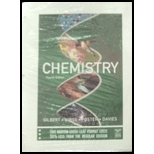
Concept explainers
Interpretation: The fuel values of formaldehyde and formic acid is to be calculated and the compound having higher fuel value is to be predicted.
Concept Introduction: The calorie content of substance is calculated by determining the energy released in the combustion of the one gram mass of substance.
To determine: The fuel values of formaldehyde and formic acid and the compound having higher fuel value out of it.
Answer to Problem 13.109QP
The fuel value of formaldehyde is
Explanation of Solution
Given
The enthalpy of formation of formaldehyde is
The enthalpy of formation of formic acid is
The balanced chemical equation for the combustion of formaldehyde is,
The enthalpy change of the combustion reaction of formaldehyde is calculated by the formula,
Substitute the values of
The chemical equation for the combustion of formic acid is,
The enthalpy change of the combustion reaction of palmitic acid is calculated by the formula,
Substitute the values of
The heat produced per gram in the combustion of formaldehyde is calculated by dividing its enthalpy change of combustion by the molar mass.
The heat produced per gram in the combustion of formic acid is calculated by dividing its enthalpy change of combustion by the molar mass.
The fuel value of formaldehyde is
Want to see more full solutions like this?
Chapter 13 Solutions
Chemistry
 ChemistryChemistryISBN:9781305957404Author:Steven S. Zumdahl, Susan A. Zumdahl, Donald J. DeCostePublisher:Cengage Learning
ChemistryChemistryISBN:9781305957404Author:Steven S. Zumdahl, Susan A. Zumdahl, Donald J. DeCostePublisher:Cengage Learning ChemistryChemistryISBN:9781259911156Author:Raymond Chang Dr., Jason Overby ProfessorPublisher:McGraw-Hill Education
ChemistryChemistryISBN:9781259911156Author:Raymond Chang Dr., Jason Overby ProfessorPublisher:McGraw-Hill Education Principles of Instrumental AnalysisChemistryISBN:9781305577213Author:Douglas A. Skoog, F. James Holler, Stanley R. CrouchPublisher:Cengage Learning
Principles of Instrumental AnalysisChemistryISBN:9781305577213Author:Douglas A. Skoog, F. James Holler, Stanley R. CrouchPublisher:Cengage Learning Organic ChemistryChemistryISBN:9780078021558Author:Janice Gorzynski Smith Dr.Publisher:McGraw-Hill Education
Organic ChemistryChemistryISBN:9780078021558Author:Janice Gorzynski Smith Dr.Publisher:McGraw-Hill Education Chemistry: Principles and ReactionsChemistryISBN:9781305079373Author:William L. Masterton, Cecile N. HurleyPublisher:Cengage Learning
Chemistry: Principles and ReactionsChemistryISBN:9781305079373Author:William L. Masterton, Cecile N. HurleyPublisher:Cengage Learning Elementary Principles of Chemical Processes, Bind...ChemistryISBN:9781118431221Author:Richard M. Felder, Ronald W. Rousseau, Lisa G. BullardPublisher:WILEY
Elementary Principles of Chemical Processes, Bind...ChemistryISBN:9781118431221Author:Richard M. Felder, Ronald W. Rousseau, Lisa G. BullardPublisher:WILEY





